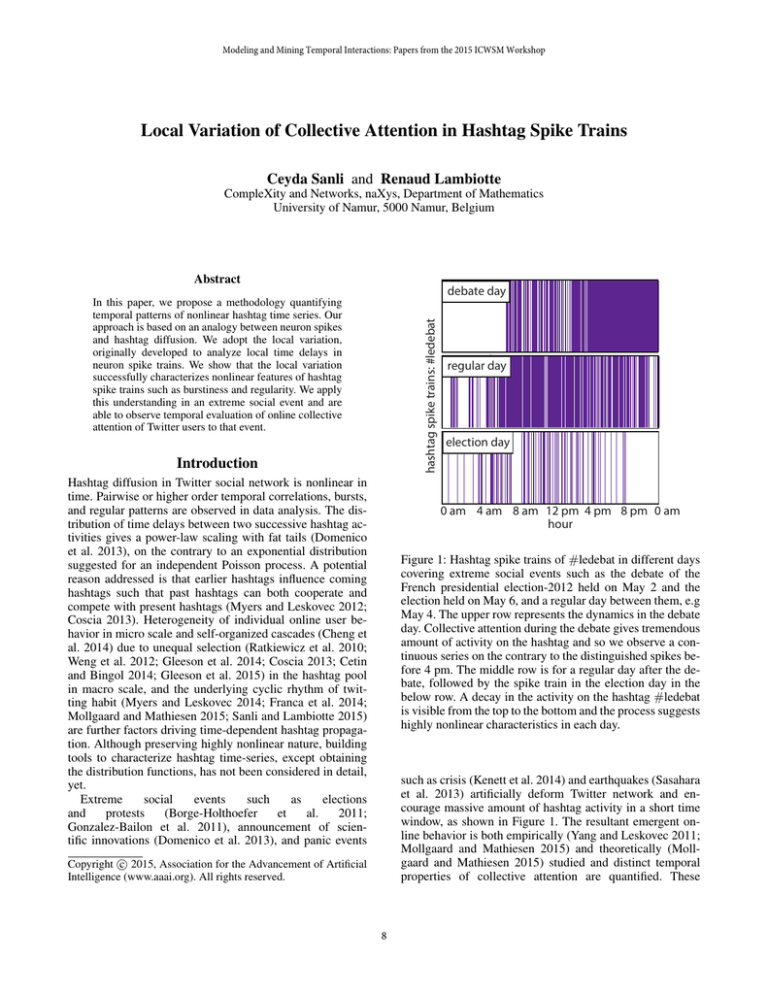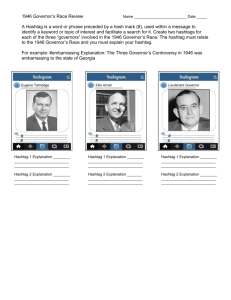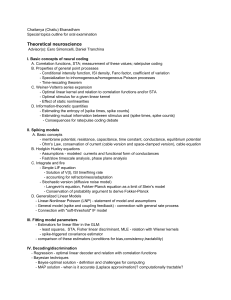
Modeling and Mining Temporal Interactions: Papers from the 2015 ICWSM Workshop
Local Variation of Collective Attention in Hashtag Spike Trains
Ceyda Sanli and Renaud Lambiotte
CompleXity and Networks, naXys, Department of Mathematics
University of Namur, 5000 Namur, Belgium
Abstract
debate day
hashtag spike trains: #ledebat
In this paper, we propose a methodology quantifying
temporal patterns of nonlinear hashtag time series. Our
approach is based on an analogy between neuron spikes
and hashtag diffusion. We adopt the local variation,
originally developed to analyze local time delays in
neuron spike trains. We show that the local variation
successfully characterizes nonlinear features of hashtag
spike trains such as burstiness and regularity. We apply
this understanding in an extreme social event and are
able to observe temporal evaluation of online collective
attention of Twitter users to that event.
Introduction
Hashtag diffusion in Twitter social network is nonlinear in
time. Pairwise or higher order temporal correlations, bursts,
and regular patterns are observed in data analysis. The distribution of time delays between two successive hashtag activities gives a power-law scaling with fat tails (Domenico
et al. 2013), on the contrary to an exponential distribution
suggested for an independent Poisson process. A potential
reason addressed is that earlier hashtags influence coming
hashtags such that past hashtags can both cooperate and
compete with present hashtags (Myers and Leskovec 2012;
Coscia 2013). Heterogeneity of individual online user behavior in micro scale and self-organized cascades (Cheng et
al. 2014) due to unequal selection (Ratkiewicz et al. 2010;
Weng et al. 2012; Gleeson et al. 2014; Coscia 2013; Cetin
and Bingol 2014; Gleeson et al. 2015) in the hashtag pool
in macro scale, and the underlying cyclic rhythm of twitting habit (Myers and Leskovec 2014; Franca et al. 2014;
Mollgaard and Mathiesen 2015; Sanli and Lambiotte 2015)
are further factors driving time-dependent hashtag propagation. Although preserving highly nonlinear nature, building
tools to characterize hashtag time-series, except obtaining
the distribution functions, has not been considered in detail,
yet.
Extreme
social
events
such
as
elections
and
protests
(Borge-Holthoefer
et
al.
2011;
Gonzalez-Bailon et al. 2011), announcement of scientific innovations (Domenico et al. 2013), and panic events
regular day
election day
0 am 4 am 8 am 12 pm 4 pm 8 pm 0 am
hour
Figure 1: Hashtag spike trains of #ledebat in different days
covering extreme social events such as the debate of the
French presidential election-2012 held on May 2 and the
election held on May 6, and a regular day between them, e.g
May 4. The upper row represents the dynamics in the debate
day. Collective attention during the debate gives tremendous
amount of activity on the hashtag and so we observe a continuous series on the contrary to the distinguished spikes before 4 pm. The middle row is for a regular day after the debate, followed by the spike train in the election day in the
below row. A decay in the activity on the hashtag #ledebat
is visible from the top to the bottom and the process suggests
highly nonlinear characteristics in each day.
such as crisis (Kenett et al. 2014) and earthquakes (Sasahara
et al. 2013) artificially deform Twitter network and encourage massive amount of hashtag activity in a short time
window, as shown in Figure 1. The resultant emergent online behavior is both empirically (Yang and Leskovec 2011;
Mollgaard and Mathiesen 2015) and theoretically (Mollgaard and Mathiesen 2015) studied and distinct temporal
properties of collective attention are quantified. These
c 2015, Association for the Advancement of Artificial
Copyright Intelligence (www.aaai.org). All rights reserved.
8
properties are significantly important to be able to predict
these extreme, but rare social events (Kenett et al. 2014;
Miotto and Altmann 2014).
Our main motivation is to establish a systematic methodology to distinguish real noisy hashtag signals to independent random signals and to extract temporal patterns from
the real signals. We apply an approach called the local variation LV , originally introduced to analyze noisy neuron spike
trains and to detrend for salient dynamics of neurons (Shinomoto, Shima, and Tanji 2003; Miura, Okada, and ichi
Amari 2006; Omi and Shinomoto 2011). After convincing
the usage of LV in semantic analysis, which has been performed extensively in our recent work (Sanli and Lambiotte
2015), we present a promising study on evaluation of collective attention by performing LV on a political election.
Remarkable difference in LV in rush period suggests that
local nonlinear features could predict extreme social events.
distinguished and therefore in this situation only one appearance is counted. We construct spike trains for all hashtags
observed in the data ordering from the earliest appearance
time to the latest time, e.g. . . . , τi−1 , τi , τi+1 , . . . . Each
hashtag has a unique number of (exact) appearance, popularity p.
Randomized Hashtag Spike Trains
To be able to compare real dynamics with an artificial and independent one, the randomized version of real hashtag spike
trains is established serving as a null model. First, all spikes
coming from any hashtags are combined, giving a single
merged hashtag spike train. Uniforming spike appearance,
one spike at a spike time, is still valid. Children randomized
hashtag spike trains are obtained by uniformly permuting the
matrix T of the spike times of the merged train by p times,
the number of spikes of the desired real train we compare.
We apply randperm(T , p) in Matlab and have p times uniformly distributed unique independent random spike times,
r
r
, τir , τi+1
, ... .
e.g. . . . , τi−1
Data Set
Data Collection
Local Variation
The data is collected via publicly open Twitter API. A fine
time window, between April 30, 2012 and May 10, 2012,
is determined on purpose to be able to cover two social
events such as the political debate on the French presidential election-2012 held on May 2 and the election day held
on May 6. Having 10 days data helps us to visualize activity
in regular days, both between and after these extreme events,
and compare the difference in hashtag dynamics. During this
period, all twitting activity, but only the users addressed in
France is considered not to deal with time differences between countries and regions and other potential social events
held on in the same period. The time resolution is 1 second
and no language selection is applied.
We examine 295,697 unique hashtags out of 2,942,239
tweets include at least one hashtag, which is 30% of
all tweets. 228,525 online users, almost half of the total online users, are associated with hashtag diffusion.
The network in the period contains hashtags directly related to the debate, election, and two candidates Francois Hollande and Nicolas Sarkozy for the presidency of
France. Ranking them by the number of appearance (frequency) or equivalently popularity p, from the most popular to the least, we have #ledebat (180946), #hollande
(143636), #sarkozy (116906), #votehollande (99908),
#avecsarkozy (67549), #ledebat (66668) [in French],
#france2012 (20635), #presidentielle (13799), and many
others with lesser p. The numbers inside the parenthesis
present the corresponding p. These popular hashtags are at
the top of the others in the pool, e.g. 0.0001% of all hashtags.
The local variation LV , specifically defined to quantify nonlinear neural time-series and to uncover temporal patterns
in neuron spike trains, is defined at spike time τi (Omi and
Shinomoto 2011)
2
N −1 3 Δτi+1 − Δτi
LV =
,
(1)
N − 2 i=2 Δτi+1 + Δτi
Δτi+1 = τi+1 − τi and Δτi = τi − τi−1 . Δτi+1 quantifies
forward delay and Δτi represents backward waiting time.
Importantly, the denominator normalizes the quantity such
as to account for local variations of the rate at which events
take place.
By definition, LV takes values in the interval [0:3]. Furthermore, it is derived that LV is on average equal to 1, LV = 1, if the underlying process described by an independent
Poisson distribution, which the distribution of the inter-spike
intervals gives an exponential function (Shinomoto, Shima,
and Tanji 2003). Here, the brackets describe the average
taken over the given distribution. All other situations can
be generalized by Gamma processes (Shinomoto, Shima,
and Tanji 2003; Miura, Okada, and ichi Amari 2006) and
LV should be significantly different than 1. For instance,
LV ≈ 3 if the hashtag spike trains are extremely bursty
(irregular), on the other hand LV ≈ 0 while the trains
present regular (homogeneous) temporal patterns (Sanli and
Lambiotte 2015).
Figure 2 shows the results of our LV analysis, for both
real and randomized hashtag spike trains. The probability
distribution of P (LV ) of the calculated values of LV on the
two data sets, with classifying hashtag groups in popularity p, presents distinct behavior. Whereas LV = 1 for any
groups of p for the randomized trains, suggesting Poisson
processes, LV never indicates 1 for the real trains. The
randomization dampens nonlinearity of the real trains, temporal correlations, burstiness, and regularity in series and
construct statistically stationary and independent processes,
Real Hashtag Spike Trains
Single hashtag diffusion in time can be represented as a
spike train, as shown in Figure 1. Each spike represents that
the corresponding hashtag used at that time without specifying ways and users. Having the resolution 1 second, the
spike time of multiple events occurring in a second cannot be
9
time-series.
Empirical Application: Collective Attention
We now utilize LV for more practical purposes and ask: Can
LV predict extreme social events? Our investigation will be
presented below is far from a complete understanding. However, we will be able to capture temporal evaluation of online emergent behavior as a result of collective attention of
twitting on the French presidential election-2012, in the first
week of May 2012.
We specifically compare hashtag diffusion in extreme
days, the debate day (May 2) and the election day (May 6)
with the dynamics in a regular day between these events,
e.g. May 4. Instead of considering all hashtags in the pool, as
done in the previous Section, we concentrate on topic related
hashtags such as #ledebat (180946), #hollande (143636),
#sarkozy (116906), #votehollande (99908), #avecsarkozy
(67549), and #ledebat (66668) [in French]. The numbers in
the parenthesis indicate p of the corresponding hashtag.
Local variation LV is obtained for these topic-oriented
hashtag spike trains. The trains are constructed separately
for the three days. LV for each train and for each day is calculated considering time window with duration 1 hour. Figure 3 presents the results in the debate (left), regular (middle), and election (right) days. The top row [Figure 3(a)]
shows LV (t) in the days in hour resolution. The below row
[Figure 3(b)] summarizes the twitting activity as the tweets
including listed hashtags in the legend versus time, again in
hour resolution.
Rush hours in online communications during the debate
and the announcement of the election result are highlighted
in the shaded yellow rectangle and with the yellow vertical
line, respectively. Significant decays in LV (t) for both the
debate and election days, synchronizing perfectly with the
peak of the counts, indicate regular activation of the online
users on the discussion of the election and so describe no
burstiness, LV (t) ≈ 0. This trend is not observed at all for
the regular day and mainly the cyclic rhythm of Twitter network (Sanli and Lambiotte 2015) characterize the values of
LV (t). While large amount of fluctuations present in inactive hours [0 am:6 am], the rest of the day LV (t) ≈ 1
suggesting time-dependent Poisson processes. These results
are preliminary, but promising since the stages of collective
attention are clearly visible on LV (t).
Figure 2: Probability density function of local variation LV ,
P (LV ), of hashtag spike trains (Sanli and Lambiotte 2015).
(a) Real hashtag spike trains. We observe a clear shift, to the
higher values of LV , in the peak positions while decreasing hashtag popularity p, which indicates that the process
becomes bursty (irregular). In any p, the mean values never
gives 1, none of the real signal is Poisson process. (b) Randomized hashtag spike trains. Independent of p, all curves
suggest fluctuations around 1, as expected for temporarily
independent signals. To satisfy a better visualization, the results are grouped based on ranking p from the most popular
to the least popular ones: High p, red and orange symbols,
moderate p, yellow and green symbols, and low p, blue and
purple symbols.
Discussion and Future Work
The main purpose of this paper is to establish a tool for noisy
social time-series and uncover nonstationary features and
temporal patterns, specifically in an online emergent limit.
Our comparative test on the real and randomized data sets
shows that the local variation LV , a metric introduced to
quantify the fluctuations of neuron spike trains as compared
to a local characteristic time, works successfully in hashtag
spike trains, as well. This encourages us to develop further
tools, for instance to predict extreme online events by evaluating the early noisy signal prior to an extreme event. As
an example, we consider the week of the French presidential
election-2012. This fine time window is well suitable for our
yet time-dependent events. Therefore, we characterize timedependent Poissons in Figure 2(b), P (LV ) fluctuates around
1. However, all nonlinearities are present in the real data,
and so in P (LV ). Describing regular patterns for popular
hashtags (high p), red and orange symbols, the trains become bursty (irregular) due to local temporal correlations
for moderate, yellow and green symbols, and for low popularity, blue and purple symbols. The trend is captured in the
shift of the peak positions of P (LV ) from small LV to large
LV decreasing p in Figure 2(a). Consequently, we find that
not only for neurons but also for hashtags LV is a successful tool to characterize salient dynamics in nonlinear social
10
3
2.5
(a)
debate day
regular day
election day
announcement
of the result
at 7 pm
debate
at 7-11 pm
2
1.5
1
0.5
tweet count/hour
0
4000
3500
3000
2500
2000
(b)
#ledebat
#hollande
#sarkozy
#votehollande
#avecsarkozy
#ledebat
#ledebat
#hollande
#sarkozy
#votehollande
#avecsarkozy
#ledebat
#hollande
#sarkozy
1500
1000
500
0
0 am 3 am 6 am 9 am 12 pm3 pm 6 pm 9 pm 0 am 0 am 3 am 6 am 9 am 12 pm3 pm 6 pm 9 pm 0 am 0 am 3 am 6 am 9 am 12 pm3 pm 6 pm 9 pm 0 am
hour
hour
hour
Figure 3: Characterizing temporal evaluation of collective attention. From left to right, the debate (May 2, 2012), a regular
day (May 4, 2012), and the election day (May 6, 2012) are shown. (a) The local variation of LV (t) on the topic-related
hashtags about the debate and the election. The shaded yellow rectangle covers the debate hours and the yellow line indicates
the announcement of the election. Significant decays in LV (t), in left and right windows, match well with the schedule of the
events. However, no remarkable trend is observed in the regular day (middle panel). (b) Counting tweets, including at least
one of the hashtags addressed in the legends, per hour. The activity increase in time coincides successfully with the decays in
LV (t), indicating that the collective attention homogenizes the hashtag propagation and so the hashtag spike trains in this limit
present temporal regularity.
aim and we find that LV is sensitive enough to distinguish
collective attention period, users are active homogeneously
in time, from the preceding period where temporal heterogeneity is present and therefore a prediction would be satisfied by performing better statistics in the decay of LV (t).
We obtain LV (t) is almost 0 in rush periods. Such artificial regularity originates from our assumption due to lack
of time resolution below 1 second. Although we observe
heterogeneity in hashtag spike trains in rush hours in the
empirical data, uniforming spike appearance setting to 1 in
any spike time creates unnatural homogeneity in emergent
limit. To resolve this, the trains should be constructed preserving the heterogeneity in the data and so LV must be
re-introduced for nonuniform number of spikes at different
spike times in a train.
References
Borge-Holthoefer, J.; Rivero, A.; Garcia, I.; Cauhe, E.; Ferrer, A.; Ferrer, D.; Francos, D.; Iniguez, D.; Perez, M. P.;
Ruiz, G.; Sanz, F.; Serrano, F.; Vinas, C.; Tarancon, A.; and
Moreno, Y. 2011. Structural and dynamical patterns on online social networks: The spanish may 15th movement as a
case study. PLoS ONE 6(8):e23883–1–8.
Cetin, U., and Bingol, H. O. 2014. Attention competition
with advertisement. Phys. Rev. E 90:032801–1–7.
Cheng, J.; Adamic, L.; Dow, P. A.; Kleinberg, J. M.; and
Leskovec, J. 2014. Can cascades be predicted? In Proceedings of the 23rd International Conference on World Wide
Web, WWW ’14, 925–936. New York, NY, USA: ACM.
Coscia, M. 2013. Competition and success in the meme
pool: A case study on quickmeme.com. In International
AAAI Conference on Weblogs and Social Media (ICWSM).
Domenico, M. D.; Lima, A.; Mougel, P.; and Musolesi, M.
2013. The anatomy of a scientific rumor. Sci. Rep. 3:2980–
1–9.
Franca, U.; Sayama, H.; McSwiggen, C.; Daneshvar, R.; and
Bar-Yam, Y. 2014. Visualizing the ”Heartbeat” of a City
with Tweets. ArXiv e-prints.
Gleeson, J. P.; Ward, J. A.; O’Sullivan, K. P.; and Lee, W. T.
Acknowledgments
C. Sanli acknowledges supports from the EU 7th Framework
OptimizR Project and FNRS. This paper presents research
results of the Belgian Network DYSCO, funded by the Interuniversity Attraction Poles Programme, initiated by the
Belgian State, Science Policy Office.
11
2014. Competition-induced criticality in a model of meme
popularity. Phys. Rev. Lett. 112:048701–1–5.
Gleeson, J. P.; O’Sullivan, K. P.; Banos, R. A.; and Moreno,
Y. 2015. Determinants of Meme Popularity. ArXiv e-prints.
Gonzalez-Bailon, S.; Borge-Holthoefer, J.; Rivero, A.; and
Moreno, Y. 2011. The dynamics of protest recruitment
through an online network. Sci. Rep. 1:197–1–7.
Kenett, D. Y.; Morstatter, F.; Stanley, H. E.; and Liu, H.
2014. Discovering social events through online attention.
PLoS ONE 9(7):e102001–1–7.
Miotto, J. M., and Altmann, E. G. 2014. Predictability of
extreme events in social media. PLoS ONE 9(11):e111506–
1–7.
Miura, K.; Okada, M.; and ichi Amari, S. 2006. Estimating
spiking irregularities under changing environments. Neural
Comput. 18:2359–2386.
Mollgaard, A., and Mathiesen, J. 2015. Emergent user behavior on Twitter modelled by a stochastic differential equation. ArXiv e-prints.
Myers, S., and Leskovec, J. 2012. Clash of the contagions:
Cooperation and competition in information diffusion. In
Data Mining (ICDM), 2012 IEEE 12th International Conference on, 539–548.
Myers, S. A., and Leskovec, J. 2014. The bursty dynamics
of the twitter information network. In Proceedings of the
23rd International Conference on World Wide Web, WWW
’14, 913–924. New York, NY, USA: ACM.
Omi, T., and Shinomoto, S. 2011. Optimizing time histograms for non-poissonian spike trains. Neural Comput.
23:3125–3144.
Ratkiewicz, J.; Fortunato, S.; Flammini, A.; Menczer, F.; and
Vespignani, A. 2010. Characterizing and modeling the dynamics of online popularity. Phys. Rev. Lett. 105:158701–
1–4.
Sanli, C., and Lambiotte, R. 2015. Local variation of hashtag
spike trains and popularity in Twitter. ArXiv e-prints.
Sasahara, K.; Hirata, Y.; Toyoda, M.; Kitsuregawa, M.; and
Aihara, K. 2013. Quantifying collective attention from tweet
stream. PLoS ONE 8(4):e61823–1–10.
Shinomoto, S.; Shima, K.; and Tanji, J. 2003. Differences
in spiking patterns among cortical neurons. Neural Comput.
15:2823–2842.
Weng, L.; Flammini, A.; Vespignani, A.; and Menczer, F.
2012. Competition among memes in a world with limited
attention. Sci. Rep. 2:335–1–8.
Yang, J., and Leskovec, J. 2011. ACM International Conference on Web Search and Data Mining (WSDM).
12







